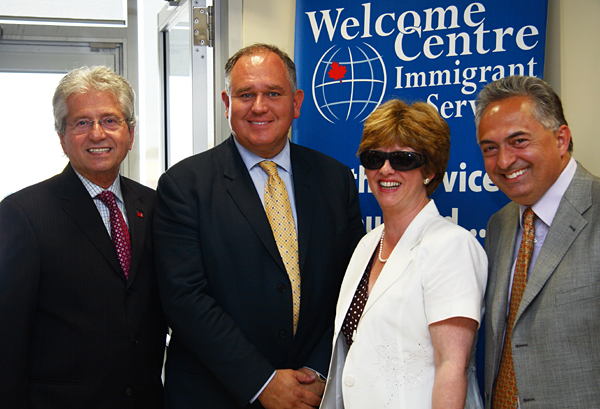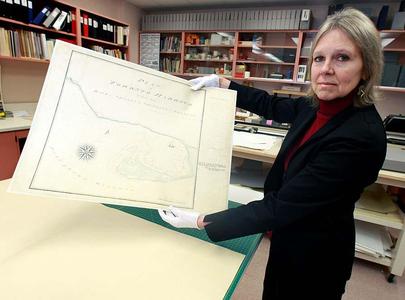City archivist protects collection of writings, maps and photographs covering more than two centuries
Karen Teeple lays on a table the oldest object in the Toronto Archives.
It is dated Nov. 15, 1792, and it is a chart of Toronto Harbour signed by Joseph Bouchette.
It is one of her treasures.
It is also one of your treasures: a gift to Toronto and its residents made 75 years ago by a descendant of John Graves Simcoe.
Teeple, as the city archivist, is anxious to share the wealth of writings, maps, photographs and records of all kinds that cram the archives, on Spadina Rd. near Dupont St., just down the hill from Casa Loma.
Her mission, in her own words:
“Toronto is a major city that’s got a very illustrious past. I think we are responsible to ensure that Toronto’s history is preserved and made accessible to its citizens.”
The archives shelter millions of documents, in 123,000 boxes. Some have obvious significance: The city’s original incorporation document from 1834 lies here. So does the official version of the City of Toronto Act, deposited by Mayor David Miller and municipal affairs minister Brad Duguid on New Year’s Day, 2007.
Some are merely wordy, such as the official minutes of all Toronto council meetings, including the minutes of the city, borough, village and Metro municipal governments that preceded them.
But the archives also house myriad images: a million photographs; thousands of maps; a collection of antique glass projector slides.
“My favourite has to be the earliest known views of Toronto,” says Teeple, from a series of photos taken from the roof of the Rossin House Hotel in 1856-57. Standing five storeys high at the southeast corner of King and York Sts., it was then Toronto’s tallest building. The photos make up an almost complete panorama of the city.
The photos are not locked away: They hang in the lobby of the archives. They are also featured in the book of official photographs that Teeple and fellow archivists Steve MacKinnon and Michele Dale produced earlier this year. The book – Toronto’s Visual Legacy – is almost sold out. It’s available at Indigo.
“The success of the book speaks to the passions and interest that Torontonians have about their past,” says Teeple, who was drawn to archival work in the 1970s as a graduate student in Canadian studies. “There are other archival institutions in the city – bank archives, religious archives – but when it comes to ensuring that Toronto’s history is preserved, we are pretty much one of the only institutions around.”
The images in photos, maps and glass slides – meticulously catalogued and preserved by the archives staff – are the most instantly compelling items in the archives.
Bouchette’s chart, for example, shows what was important to him. While it meticulously describes the harbour bottom, he notes only four features on land: Two houses, “Toronto fort” and an “Indian hut.”
Another map from the early 19th century shows the early Legislature building just south of St. Lawrence Hall. On the site of modern Queen’s Park sits, in the brutal language of the day, the “lunatic asylum.”
The photographs tell their own compelling stories. Michael Ondaatje refers explicitly to the work of Arthur Goss, official photographer in the early years of the 20th century, in his Toronto-centred novel In the Skin of a Lion. The Goss collection is housed in the archives.
Not all are deep in the past: The city commissioned Peter MacCallum to take photos of the demolition of part of the Gardiner Expressway in 2000. The archives has many photos of Toronto’s artistic community by John Reeves.
Archives staff are currently transferring old photos into digital form, where they can be viewed on the archives website. But even dusty documents help bring the past to life.
The archives, for example, can be used to search for information about homes in the city.
You can look up your address in city directories dating back to 1834. Once you find the first reference to your house, you can switch over to assessment rolls, which are on microfilm and which provide some indication of the owners or occupants of the dwelling, year by year.
Meanwhile, archives staff are working to improve public access to the collection, especially its 1 million photographs. About 45,000 have been scanned and can be viewed on the city website. Prints are available for sale.
For detailed directions on how to search, and instructions how to research your house, visit the archives or go to the city website at www.toronto.ca/archives/.
Take our FREE Online Assessment Today!
Socialize with Abrams & Krochak
Government of Canada Makes it Easier for Temporary Residents to Apply for Work Permits or Extend Their Visit in Canada
Temporary residents seeking work permits or an extension of their visit in Canada can now apply online, Citizenship, Immigration and Multiculturalism Minister Jason Kenney announced today.
“Extending our online services to more temporary residents will significantly facilitate the application process by providing faster, more accessible and efficient services,” said Minister Kenney.
Forms submitted by mail often need to be returned because they are incomplete, adding additional time to the process. Applications online can only be submitted if they are complete, thereby contributing to faster processing. The service is open to all temporary residents except for co-op program work permit applicants.
Citizenship and Immigration Canada (CIC) intends to make all types of applications available online in the future.
CIC first began offering online applications in June 2008, international students studying in Canada being the first to have access. Since then, international students have submitted close to 33,000 online applications. International students at over 200 participating educational institutions have been able to apply online for an off-campus work permit, confirm their eligibility online and renew their study permit while in Canada. They can also use our online services to apply for or extend the status of their dependent family members currently living in Canada.
Applicants can access our FREE Eligibility Assessment today!
Furthermore, applicants who gain skilled work experience in Canada may be eligible to apply for permanent residence under the Canadian Experience Class.
Take our FREE Online Assessment Today!
Socialize with Abrams & Krochak
Olympic torch relay takes detour as natives protest in Ontario
It was a joyous Olympic torch celebration in Six Nations of the Grand River Monday night despite earlier anxiety over protests hindering the spirit of the event. More than a thousand people gathered at the local bingo hall, waving Six Nations flags in support of the flame being passed through their community, about 90 kilometres southwest of Toronto.
Earlier in the day, the relay route was altered amid growing anticipation of conflict with protesters. Instead of being carried through the town, as was the original plan, the flame was passed by the 25 Six Nations torchbearers doing laps on the path leading up to the bingo hall where possible protests easily could be contained. The roads surrounding the event were blocked and Six Nations police patrolled the area. “This is really exciting,” said 12-year old torchbearer Caytlen Burning. A resident of Six Nations, Burning excels at running mid-distance races and is an Olympic hopeful, herself. “I’ve always wanted to go to the Olympics and this is encouraging me to follow my dream,” she said.
For Phyllis Bomberry, 67, a former softball player who grew up in Six Nations, the flame represents unity in athletics. “You play sports and it doesn’t matter if you’re black, orange, white, it doesn’t matter — you’re together,” Bomberry said. Bomberry was recently inducted into the Canadian Softball Hall of Fame, and won a gold medal at the first Canada Games in 1970. At a news conference Monday afternoon, Six Nations Parks and Recreation director Cheryl Henhawk said the change of route was to make sure the flame was successfully carried through the community, and to ensure the safety of the torchbearers and spectators. “There are people in this community who want to see it (the flame),” Henhawk said. “We need a different venue to make this work.” Six Nations Chief Bill Montour alluded to the momentous nature of the event. “This is history. This is where we show the world what Six Nations is about,” he said.
Protesters arrived outside of the news conference at a local recreation centre with banners reading “No torch no trespassing.” “It’s a victory that we have the power to get our voice out there, to change those plans. It is a victory,” Melissa Elliott, a front person for the resistance, said of the change of venue. Elliott said she is protesting the Olympics as a call to fair treatment of aboriginal people in Canada. “We are a nation of people. Canada is refusing to recognize our treaties and our sovereignty,” she said. Six Nations torchbearer, Justice Harry Laforme said the issues being brought forward through the protests are “legitimate.” Born and raised on a reserve, the 63-year-old Mississauga native said he grew to realize the voice of aboriginal peoples is not easily heard, so he understands why many protesters chose international events to raise awareness of their concerns. But, he said, an event such as the Olympics has the ability to bring people together, differences aside. “I look at it (the Olympics) as an opportunity to demonstrate to the international community and to Canada, that we’re part of (this country), and we believe in respect, equality and acceptance.” The torch relay was briefly delayed last Thursday in Toronto when hundreds of protesters filled the streets shouting, “No Olympics on stolen native land.” The land claim issue has been a sensitive one in Six Nations.
Located about 20 minutes southwest of Hamilton, the area has the largest population of all First Nations in Canada. Earlier in the day, the flame exited Niagara Falls and passed through such communities as Chippawa, Fort Erie, and Caledonia. As Tracy Phelps waved the torch proudly from Rainbow Bridge in Niagara Falls on Monday morning, the spirit of the moment wasn’t lost on her friends and family who came out to support her. “It not only brings us together to celebrate sport, but people and relationships,” said Mark Cushing, a longtime friend of Phelps. A light snow fell as hundreds whooped and waved flags beneath the majestic steel bridge connecting Niagara Falls, Ont., and Niagara Falls, N.Y., across the Niagara River. “It was unbelievable, with the falls in the background, knowing my friends and family were all here,” said Phelps, who was born and raised in Niagara Falls. “It (the torch) makes everyone feel like a champion.” Phelps’ mom, dad, sister and a large group from her church were out in the early morning hours to cheer her on. “She deserves this,” said Sue Ferrier, who attends the same church as Phelps. “She’s an all-around great person between her commitment to sports and her way of life. She’s such an example to young people.”
A youth pastor at a local church, and a volunteer basketball coach at a nearby high school, Phelps, 40, who is also a basketball player, is known in Niagara as a community mentor to kids of all ages. “I’m proud of her. She’s an awesome person,” said 12-year old April Cianfagna, who has been taught by Phelps at her church. “She’s a person I feel good about.” The torch relay was to pause Monday night in nearby Brantford, Wayne Gretzky’s hometown. The flame’s unprecedented 45,000 kilometre trek will conclude in Vancouver at the start of the Olympic Games on Feb. 12.
Take our FREE Online Assessment Today!
Socialize with Abrams & Krochak
Government of Canada Invests in Four New York Region Welcome Centres

Take our FREE Online Assessment Today!
Socialize with Abrams & Krochak
Archives
- January 2024
- November 2023
- July 2023
- June 2023
- May 2023
- January 2023
- November 2022
- April 2022
- March 2022
- February 2022
- October 2021
- June 2021
- April 2021
- October 2020
- September 2020
- June 2020
- May 2020
- April 2020
- March 2020
- December 2019
- January 2019
- December 2018
- November 2018
- August 2018
- June 2018
- April 2018
- January 2018
- December 2017
- November 2017
- April 2017
- January 2017
- December 2016
- November 2016
- October 2016
- September 2016
- August 2016
- August 2015
- January 2015
- December 2014
- November 2014
- June 2014
- April 2014
- March 2014
- February 2014
- December 2013
- May 2013
- April 2013
- January 2013
- December 2012
- August 2012
- June 2012
- March 2012
- January 2012
- September 2011
- August 2011
- July 2011
- June 2011
- February 2011
- January 2011
- December 2010
- November 2010
- September 2010
- August 2010
- July 2010
- June 2010
- May 2010
- April 2010
- March 2010
- February 2010
- January 2010
- December 2009
- November 2009
- October 2009
- September 2009
- August 2009
- August 2008
- July 2008
- June 2008
- May 2008
- April 2008
- March 2008
- February 2008
- January 2008



